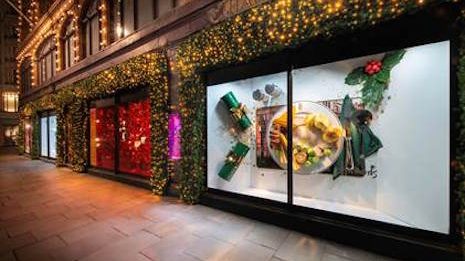As the final weekend before Christmas begins, consumers are turning to both ecommerce and bricks-and-mortar to finish their holiday shopping.
New research from KPMG shows that nearly 70 percent of consumers still have up to half of their holiday shopping left to do. The majority of these last-minute shoppers will complete their purchases through a mixture of online and in-store purchases, calling for cross-channel retail strategies that minimize friction.
“As we get down to the last few holiday shopping days, consumers focus on convenience, including last-minute delivery, and personalized products and services," said Mark Larson, partner and head of consumer and retail at KPMG, Chicago.
KPMG surveyed more than 1,000 consumers between Dec. 11 and 12.
Down to the wire
Nearly a third of consumers, 32 percent, said they have between 25 to 49 percent of their shopping remaining.
Only 15 percent of shoppers will finish their shopping entirely online, while 59 percent will do their last-minute shopping between online and in-store.

Most last-minute holiday shopping is done at physical stores. Image credit: Neiman Marcus
The majority of consumers, 59 percent, cited gift cards and certificates as the last-minute gift of choice. Forty-four percent of shoppers also said apparel and accessories were popular presents to purchase the week prior to Christmas.
Despite shoppers’ last-minute tendencies, more consumers shopped on Cyber Monday this year than in 2017.
Up from 58 percent last year, 69 percent of consumers shopped on Cyber Monday in 2018. Nearly a quarter, 24 percent, spent between $250 and $500 on that day alone.

Black Friday and Cyber Monday participation was up in 2018. Image credit: Roger Vivier
Participation also increased during Black Friday, with 72 percent of consumers shopping either on- or offline that day compared to 63 percent in 2017. Twenty-eight percent spent between $250 and $500 on Black Friday.
During the holiday season as a whole, 20 percent of consumers plan to spend between $500 and $750. More than half, 51 percent, also expected to complete up to 50 percent of their shopping online.
Retailer efforts
In-store shopping still remains the most favored choice for last-minute purchases, but retailers must also leverage omnichannel strategies.
Research shows that click-and-collect services are more popular among female consumers with higher annual incomes, exhibiting the importance of luxury retailers including these services.
According to Order Dynamics Research, the “click and collect superconsumer” is 24 to 49 years old and has been well versed in omnichannel retail for the last two years. This consumer is also interested in the experience of shopping, needing to touch and feel the products she is purchasing (see story).
A growing number of shoppers are also turning to store reviews to find and evaluate bricks-and-mortar locations.
More than 80 percent of consumers are using their mobile phones to search for retailers, products and more that are near them at the moment, according to research from Uberall. Leveraging the keywords “near me” and gaining visibility in these localized searches is a key way to get consumers in the door (see story).
According to another survey conducted by Uberall, 19 percent of respondents admitted to always checking platforms such as Google or Yelp for store reviews when deciding where to shop. A majority of consumers also believe brands should reply to every review posted about a store (see story).
Retailers' online presence can therefore have an impact on whether consumers turn to their store for their final holiday purchases.
“When it comes to last-minute shoppers, everything starts with mobile,” said Tehsin Daya, vice president of business development, North America at Uberall, San Francisco. “They’re mainly using their devices to search for brick-and-mortar store hours and nearby shopping locations.
“That means each store should have a localized presence across platforms like Facebook, Google, Instagram, Foursquare, Yelp and others,” he said. “Retailers also have to make sure that basic store information is updated on these sites to reflect extended holiday hours.”
{"ct":"F7etpbXLFBaxCNv0qWYi8g25PG7fkAoM3+s1SJVf3s003iLhi8SyGP6a5qQMxLhCsTroU8tQ1d97LzMDrRWNv9\/ovwLEuFnYRlimkzHsyqvRPZ3wvEbvLkghPtX7F2yqGJi6dX2pV+46g6c8Jto5HX4qW7eo9LT7gseZFVwDrsyOXHJFQTwbHyKOliZC6c7ec4KvDIDc14aKkLH5XQWjytILx64qSInS3Hqlb+8NIrkBzdTf3DpELL0xvb4savif\/5406fkmuK87YZtUBQzmNcITVFTZmSZjQvyx+lrw4Qkk7GTO4tHDzBPuxEMw9666JT\/R0EBunEfhRvbx63w\/5RoI6a6AU2skO7uJ1C6ejmDtjBzmXlqQZG8kl9Czr3bg3\/WU89XvvfpCtGBwVqIaHzfWHfdCGoCFbM4t8DzvBYP0x1lyIyS7KD9mQX+HxjUTeKNkJbMaprws6SMwEWT9uZB2LRSbhkW84R9bIuJsIeyTW9KEr8n+tS04ZDRo+FnwBlRRRVoUVnoAG176+yCnxi5b+uExtHpImXn9qrvxwNS8hv0jGSGqLwwlRJwjmT14Z9FSd2kttw863K5rE6UMgULHyt6SlJJkkFLASOocY94kGYqXYn\/qn8R7uZEk\/5wKWotoy8bWbN8+SUVgKo7zCYNCl2ai7RoEatFZRadfO66pHOPRDVK222Br3xNnIpMI9cwWSYuzauaoW0fhKOmfLeHdzHoEqheLCJnn7FXpLpgHUmuEzJRvKerFYSNXeN4fT\/JoVDp739VatOHF0RKcmBL7TlrJ\/P5nlhBmsFZSJAPIr1MEgZdwOtpFgycFkJ5PiBu2M3DbvOGSt0lFFMYoZhFQVMraJe6Y15raYbBlI3kjLM5cpSVZf02Du7uw917nhIovXV6FRa0YTkCVIYjf0E8kzYgL2\/Ui4UDABXxs36QSfkXR4pBRAwLpsmmpc7rTIuXOEidptD12ES4mDaWdmHD7DkysrQ11HFci5ALJAFyKMIDx0eBXMnpTtGVcBqKNLimkIC7FkqvbfZBDqv7Uekygksle\/zXfab0uvOiOovxdkK+qm0z4vzRdIBIcfAr+L\/V0CmX18Go3Ipifa81dotdekRZUlCtlefvnn6vMcBuIM5L3RJtAKYLseSNrul6Tm5l20dCzqdZcg6Kqendc1KjVKXb18hOY\/l4HsSVp3rg+heXyJFVXVIAZ9VQdgRQXDNJtz5Lf7vU4J20K5WycV7eB1StSq6Ng7PqXizoZDZBAdzjuwuLUyPeo8f8vhN8vFLOIkc5l5mcqx44SVFsVGldQ6VVHzsVCJynbkKh85G4bNOZWACDBgWxT\/o85JSKi5O8tCPbRvAQPZyReqglNTAHwpWPJBItyHs2uBGMModrOZcQHexxFsWk\/Kdn07BnEDIatkdlutBsV0mPISK26IsV0gGE7vxFrLggZaBZW\/n9nV\/b7\/mv05cpH7KIBoXkU3H\/HCv8iz382+8evsoDB3Y0K7DCWsA+iWCkHZ3qEcZSPeZT9M1fxzfaMkG4ZUJ6D0MIWvh3+Hix\/5UOnhoKyFCeK43rpjBkMXt66iHWDx0502OzPxxO4DB3t5LrovefIHwG7\/8WTn4iVup2y4OZnEpb2C14wrypSji5vfgQTxAgt95\/w9nQQrIV3yYVo+4lfF6b\/t1wLAe\/qZAaUPrl++XhtUIFbGjGwjxxP+lkPW2g0nsXsmLC6iQyw10PLBbPzTOV10w39SptLlm76DC6HO2cAw9g8vYlySfobLP8csYk2a4lfny7D3NbOMOFyJ61PqF2bjI2\/m5ahMWhbnkAVyWby4eC4GGgJ7OTf\/IVAahXe6\/KF9CeOtrRQdoidxK+kCNq0oV2cbXl7pqaWdef9AiHGh7\/eJF7Gi10j6J3aJrLY1e01PZeec4L+oxkMexYTbASLhtK3SN5iEzNxYjrYX72hHfxuQKrrCNYdru2HlT4CZ5Y55f83EbSvBzloRzFgpBNeFaygC4EbPxvKMufqeNZNa6WBKVVXiavm6LL8n8pKmf2FjreQQ1JwPO4aHeSNnFcXgz2wl\/3m4\/hOyeoIVtzBMvSjVAoAN8JSNvYUhRnx8OhLKeNcvXZCEh1Fy5urii6Pk6pEIbMWJn7GEVPqdDcc8zA5xjq93Yd\/ZNzUqg6pF8kdRzKMqtNVY734xz1FsVYrKqcF0K7fvFUwRQAL1QMTbGedvHss1P9j96lWtchM\/56ki8TASNHmMOO4+tMGIV5ege2Pdkkc8FFR\/JRiyRfvtaf6Us65VoHNw0D6VHZZMyxo9RvysYCjtjkmYdGvAZfMu4pATbsOFE1A3\/FRJb2PX1cbZBfvUVFJZ\/VdbIRdW1CBPcfCeRlKq4f8K2x8dEicmclVh1iiwD24yr1zbpfgmTv7rncL5FcyHDH15wtrRStsyDjmc5bMDZW9aXDj4LTMQPiCdGxk+a+Y\/oYy3ecHPyRfYgeqoECdJpOROed0aVgaxLzg+K28ezLktmM+G9NN19VAZ4QklPRf4WZuuoqneqYF9Coo2Gh4WBkRGHya6B3r6m3StZW50F5k\/wrQXpx3RoozCNXtnKeXem93eZqL1WQPywZhnaYwkzdWNQd4q0PJNEdoalKFW76oYBLwpP1ND9KDlCvDNFpZBhyDSA4M6XDjsW5yvHCFwrI7Jj6nabkZ3t1uOoCmQJGHG\/Bzot1SBFJtYl1HKKyxTxe\/Gp0b2vVFkgir7cHRyoyEYD87u7iOP0Svyq54LP5\/wvpBmParlA20C39mb7ADL7ElLS9\/7+XoayuXOGfIfZlwmMms+l6m\/wLSB+NGNwwBCRzaG52bUdIu5P8vrfwfGYhreVkaAcM6Q87ZqgUQ8U+bMwsYgJSbc+SxnPnhSXw1oIGRK+x7TCGlTtx9mqgY3GGIbDES\/ZBFi4pATKVa6bA69nNeFmVOITSW+iXm5UWHEW3j+KN9AJk64zTcmFi8foQKhHzZBeobRnbWNNIzAwL36L1W\/63kX47XdC540z0EyU+gVsyiIeWNyFWDvV3Y2U\/kri47g2v3zeV8QdgWELjpiyv9uKeqecrx6hmCdWocNHWHrLraWUD5E1ikFJVFNeyc40KuGUcPZ7pfvGgVZhBePehVaeqgG\/zkA7M7hRBxsrddQuDBIOrovjzs2JN5w9VB\/r3Ff5XwQ9gy\/AmLAzllg8LfcgWYBHD3zi2rpPnbgSmugvldwiXkEFLJD+vwRPUuD7x7XQga3QGpyxBtOxP7FuS6kIiyCwVE8oa7KwofDIa+\/kIh9zB0YW0XQh7wRCxDrJBGZ9NI95\/BcvDeVEt4gCz15kn7GNuRihQvGIFew77ZuOtocwJO5Fr5vrI1pFYCEhlgF4MMSPtlIIIeaXjNzB2stLjSvhLk+WkwJ7Alk9LNIZyQHjhPPDcMfkGoYACTb2\/hbQRAlHidm5wLdVV925e0kNkFpWvWl\/ZmVHIwTWFZOeLPZ03KIIlHCM1f4oZ1kFYNxE4H2jd8CU3qVAsH1e94TmKgbV\/YOw53cvYEOhV488hqRaPzdAy73L3Wed0sjN2ASK2VNX8VT7ynYWlLsp+SyBOTWymfrkB5lqNM8U2Sf3mBgebBHfkShA+xQv1Mk9NVxxyKFvNt3\/Ot04tlpO+PY0w+19VQqEKuJEn0Advpt66xe6D8bwGOY4AxtfRjoev02dzCWTrft6tDkQf80v1iHlE3\/yvAPUI6G3py2zvbemQKGXmbEJHzowsQjjEh0mOCzrdncTVVIgOkMG1kpG+bMemJJb1bD3mOwaB6d3+JnKGTYeWHzHrv8age7qNREJeXZOkYtMyMIbVlxThUhlp4Q00OaEgeuUc12mVrzJWuS3mQ0dZuFQS9mVSAF7ZlM1SRs8qLK6liTPjvouAQNzy98qqq9Jt+QgseP\/ftLAqLOkx0CLwVA5aMCECP5guGYSBIpgatlyzSq1IQXJYj10wcdd6bBH4428Pw\/BvDQEMPvvrQp9bUtTleMdQeKaXJmu+RlBGu6Cu3D7Usrj6WJ4G1O9SsqcvHROEaj7McDAd+jFpSf9eJbEQ1qjotfV2RDr\/YbPHZG82wwrsIZDTwp0svCv3N6aM63nTwxkF3J0L+hmcTWqI7sEJBzgQse9JFxbetsSs0SVI1HIvb5Qh69bPNS\/rfxN8gZo9SlshsZdIi+ik8kXTUnY5L7Q4Xv9DWQvlrMrdhe+ZCCzmPfOSTAYHe0SsAN7GHH7DT8acOx\/jl3DX98KvCtGfk2DJfb3pqSmJoHFpv+Q9ZdNRYzMFzxN5ETEOMpkRnYQbxVRt5frlsz6egowqFJUKMYu6EedhP4aDGho4OmfYU3m7A4tZwVZwMXRp5dNM9zgsekKWFJTIorKLkKkugWpv2ippsRwOREq8toPBqjF2MkFUHI9QDiMbahDIcnMd62m\/CWPUCTjfzeLI6N5MKuG2O5MNs5ccusQk7VIwUHd\/FJ6jp1CNt55JgprVhJ5Bl9JzuqAS0C9T+scqzBmJYruhR1\/GOzApIbQhz3GqFUp0mTV0RGSZKpU79ItgVQHsOII5dGjbVUi\/QYa0k4+ny5DXQ2rPkpVLHoVXUQqSyr9WLJpzgy97l1tT69l7i\/m0eH3FmxCJvM7ZVp0x4NUpYH\/2t+aItWn1O5Azk\/0TWg5F47WcXaFdYxIa9BQZIzoNv\/WqGkJ3MMinfpnpFYKC4cpwuBr1zRiuZbA0GzZVFuo5BCjDMcuFcAAOmNLQ5+mH6BxPhwtn7xmQ1Zq8QlVNCZe\/tOk5R54mIKzKItTID9lCNwmEocE9OBPnd6h1k+zQxZ647euYWYiW1j6YSDXn8hWCTggZINAa1YYT6Zgm3qdZ0IVm36afQw4jfx94h\/WKmxC4\/GFhe\/Q13ICgVhcm2OYsMr+Llf1GKqS2TfFdE8xPRfgfuqnKcFaKSuLeh1lFmZIlTPnFuhJ3nuoVQhkH3fXMb\/+95JyvDVRhRoFwiH38MWgF1nNO6cX8hvdFacqJLLQfArCnJkByZdG4qZI\/A6SIGqah\/7hyBM+0cKD2YttV8m72J5SzlCz2mA89tUO4snmOw0\/\/QXdXNeYWP9rnmTxUKBhc5WSFk3U\/SOZ+l0Rp4lRCknAAeot8QRxnIe8AZtvIcgpmmlkP+lEcc8wiC2tQRU5IpeX8XStnAIp2hlHd\/5bHyUKQ+v7pMe6Dmpcqgg+Tyra70\/GCFER0lpfom8bNgeLfzfH5fg0ZACgeKCqLVxsyjp0n+veyO0BJVRSynKdXAr5qvur\/0VDWVyYp+hYcQG0KwRW7eOxtN7oA1N7eOdYrpw+RYkfLsYNGYpwVn9gSP7LHGPS1DmS97SOK9lwyDjyjAjgtkznbbAB9gdE1vZI4P9tfvdt9VUtAsQ\/N484GrzLCrK7\/7ZanZ+IKfcAe+gyq0Uw6XQsfVRHRYJUKSsHyDY9TQOGq6m\/FLHGlQnphj5XTS8rEHi43sdMSM1ljOFAdIgGKATWZps9T0zbOceb5cG250tehxFZnVchknPF283KJvfuuFdcgWTGZwFt8jHF1UvkwNBEclM4x7WqjJQODjvLxelMpetfhYbwfsN16PahAL48IKMYdUsKMuK5On943MfoW7t9uJ7XMvp9xMpIzVu1wTKGJ7X5sV+gvqO\/UFGVVUwcPcfN+581qTM6y4L7U\/JAMFhzZHd2Mu7pIZMHAozUDu5CvJfhfLF0CUzfYPHENkimvkwb0lsJbf\/OIS+VmPh5jSQpOEVRlJRuYzDEke4kYKqnKF8esiKxc5cptYX9+iqFkDMF1CNML7SayFwmJ1crAdpuLnTtTkA7EEXSgkHwxF1D5ZsvIjOK6+UlhcXkSgL+S5Ju2zA0x0lh9ED1UDxCy2Uu\/58bOurRuX1EcWjSwqlcgwFRt9gMUZ29PG8WY2BomJxKtQWOfZrIXv05Rf3HOM9ECAQKlKKw9jtlj+cetKLyOSgpPdc5IAYTw6Xx2omA4Qk9YgJ1ppiZpqz9\/Ev+Um9SdoW16XVDOGG9NeJG8XidMeoOttILcdTWclmyfTgwyrqKObQjplGmaCjmljxywE3GVKjPQidn84vTyopWyrlFmIpAl26MiG7+68lZEiTp20jskM0KTaVFtSsPXsif4NlS5loeAtLNxTuG9mIy3p3lluE3FVezQ4QD3HFUXzpJYuok2kHbSjLqm9eGZjmfHjzFqsH\/F6N9aoq6Mg5sxk\/Z8xT9EUwoLebOawREdahutLmbrl\/Ux7nOR8ArkFiDQ6\/jkWS\/F5g7cViMIFuitQ6Jvkeca793x7BLScyjVwUgUwekbhWxyS9joBEs+0c2D+51DazhoZElJ9V4Pppq7eD+zZiAbV+w42uJ4ZHU5Rir83a455jcw8rRnUsHzVMtTYUDJH\/zT8W+zL50kYtLjUBZRPBo\/2PNU4gUcSsF8WPHcLoStb2j4V3uFDMwi1V7ZCn\/RzEfrenM\/lLO63h5MqpvvsQNe1HnRpaNjbBQEJ1mV7orfnW6OoKK\/HtA3TxCkOF8cou9\/0AC8MsIT2ZsfoikOm5JA8AAiZCdhn+wv5Lz7L940+sXHIbqnYfHLnn58Aqgbb5AG69PDXsWqOstkI5LNQhc8xU0ypadVVRaxCesvPMbcWYV7u0gdnnL0Krck4fi3efhJDBnlwaIzC4w7ZGtFurIYSZFs8YsLbdLgyS4LfaxCtLdk2EJ6llsX1aCC4pob\/G279tFcB46+JvbAHd6zZUG4k3nf1LScj1W93GJ\/gdF5VxPV20xsbuU683gHypsU4p+AccnBSkFwwYLrWZ8DWD837T6TqXEod+Nas+opXQjD\/PSqNhOFNWCZjPUbo0I\/HqXjh12aF9VIq8x+jhYubR5oCFowSHzSgdLKNrq9arngylnIdo9oqMvvf61DD\/zShHFF2Wmn\/Mkch7b+5JV\/hPJS3w3lufdLk\/BtRDCCIC4rnjnAR+ytjoLSErXfpNUl1tzCERT7UY3MxDK0WJrQ3QSVQxo0ZsCcRIQj+ao+MF2ScWvd\/gK06mk1ERXF23KFjP+huj2ft6RXq6zumji0QGbkhXxhaIPu\/XXxxJkJ9cgIAbqS202KmTxDjH26\/20cLIeoxOQaEnET30r8U1enU4bIPHNb3zsVNiGTB90rB9Ty6CcebwOWIaNVN6Lj+NCKidJEdCV\/J8VavDsyKCviYtSfNHV3qL+J2C21aCXugsleeNWMUR1itkEsEyQ1rVdop8l7TlaXku+xQA4cDgxdngjY1mWsWYGLW9qfH2au37D1nrouvX70U\/mHrKhJ99nCe8AkpOB0eOwAsCpf+n0ybvBAF4dImtt3rWnOiGnAnldRfTjpj8Nzrl1PZEBYVsk6nlCQggferQNam1ucuRG1g6XnzEhy\/e2\/B142mNJ\/BfMIdUSV0n9VBf\/yebnCgiNx8g8HraxMjXmxtbJJ9\/1quKSmxM4AtHDbGqdxuduxEIwqsL6CnQ7weynU0Q4LtFTc9lr3dxDXxZGwPMZC3Z3ic2nwSy2KaMGfTBw5m4NEJDvApaVPYE1dlmD8\/LA042amU2OKRwauvaClpRdXGT\/0P2WO5vj5tCYnTsQJ91hOWxcibAFRPuGlmlF0Jl7ag\/+oHQjucki4yE0vAyNQXkt7wJvqRgcgB1ISruRLOpNDoA0W5PZ2rotANwROwNn3vpUnVXwXSmkAmqJtcAdvW8BCVO3v0D82oxPmbRAZeE+mf5Nkl8ib+ZiuLgggFLXvY23D7++Ke7BMh5xd6ufW538rcU4SJVWkJ4ffjQpA20Pp4","iv":"c6cedb6ad1beb1269a13b812d66742fa","s":"255a932654ecc5ac"}

 Harrods' holiday windows. Image credit: Harrods
Harrods' holiday windows. Image credit: Harrods